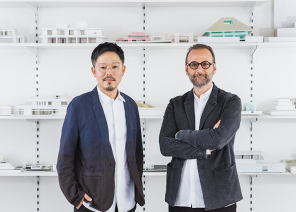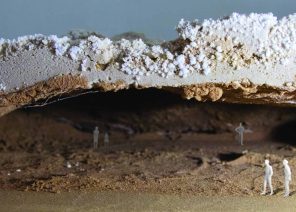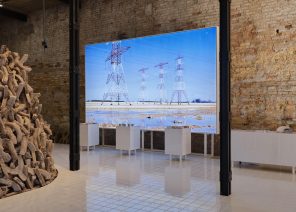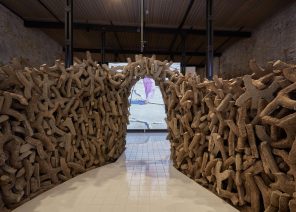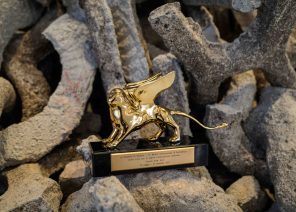2021
National Pavilion UAE searches for environmentally friendly alternative to Portland cement in 2020 Venice Biennale exhibition ‘Wetland’
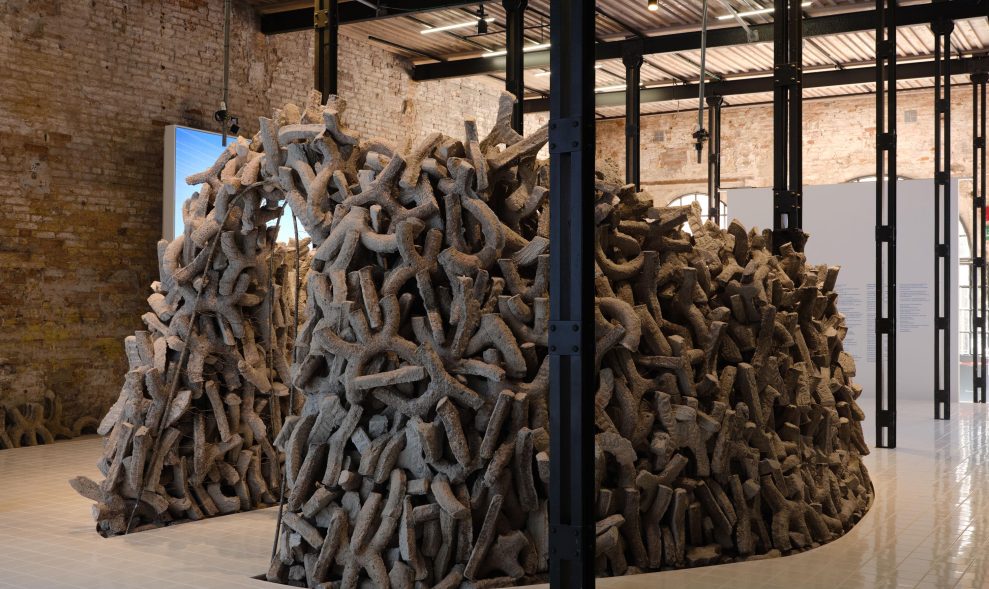
2020, United Arab Emirates: The National Pavilion UAE at the 2020 Venice Biennale will present an experimental solution to the critical environmental impact of the construction industry, with an exhibition exploring how salt and mineral compounds found in the UAE’s Sabkha (salt flats) could inspire the development of renewable building materials.
The exhibition, named Wetland, is curated by architects Wael Al Awar and Kenichi Teramoto. Through scientific experimentation and research, the curators are attempting to create a technological equivalent of Portland cement from the crystalized salt and minerals that form the UAE’s unique Sabkha.
“The cement industry accounts for 8% of all greenhouse gas emissions, in its production of concrete, which is the world’s second most highly-consumed material – so developing an alternative construction material without this high environmental impact is vital for shaping a sustainable future,” said curators Wael Al Awar and Kenichi Teramoto, Principal Architects of waiwai design (formerly known as ibda design). “Sabkha are among the UAE’s richest geological features, and their mineral makeup has the potential to create a renewable, natural building material that is equivalent in scale, cost and strength to Portland cement. Through the Wetland exhibition project, we are experimenting with unlocking this potential through a process of scientific research.”
Laila Binbrek, Coordinating Director, National Pavilion UAE – la Biennale di Venezia, said: “The biannual architecture edition of the Venice Biennale is a platform for architects, curators and global thinkers to collaborate and share ideas. This year marks the UAE’s tenth participation at the Biennale, and fittingly our curators are contributing to the global dialogue around environmental sustainability and climate change from a distinctively local perspective. Their work draws inspiration from one of the UAE’s most abundant and unusual natural resources to create an immersive exhibition about living in balance with our planet.”
The exhibition will be presented at the National Pavilion UAE at the 17th International Architecture Exhibition of the Venice Biennale from 23 May to 29 November 2020.
The 2020 Biennale is being curated by Lebanese architect Hisham Sarkis under the theme ‘How Will We Live Together?’, which encourages curators to consider how architecture can address global challenges requiring coordinated action. The UAE’s exhibition responds to Sarkis’s call for pavilions to look at architecture’s ability to engage people and communities across increasing social, economic, political and digital divides.
Inspired by what Sarkis calls “the overlooked role of the architect as both cordial convener and custodian of the spatial contract”, the National Pavilion UAE’s curators have partnered with teams at New York University – Abu Dhabi, the American University of Sharjah and the University of Tokyo (UTokyo), who will contribute to the exhibition’s innovative technical research. In partnership with Alserkal Avenue, the 2020 curators occupied the space of Warehouse 47 in Alserkal Avenue, displaying samples of Sabkha, images and some of their experiments in preparation for the 2020 exhibition.
The National Pavilion UAE is commissioned by the Salama bint Hamdan Al Nahyan Foundation and supported by the Ministry of Culture and Knowledge Development, with a permanent pavilion at the Venice Biennale’s Arsenale – Sale d’Armi. 2020 marks the UAE’s tenth exhibition at the Venice Biennale since 2009 and its fourth participation in the International Architecture Exhibition.
About waiwai
design waiwai is an award-winning multidisciplinary architecture, landscape, graphic and urban design studio with offices in Dubai and Tokyo.
Known for addressing the social, environmental, economical and technological aspects of architectural projects, the firm has worked on prominent cultural institutions including Dubai’s Jameel Arts Centre, Jaddaf waterfront sculpture park, Al Warqa’a mosque, Hai d3 and Jeddah’s Hayy: Creative Hub.
Formerly known as ibda design (‘start’ in Arabic), in 2019 the firm was renamed waiwai – a Japanese onomatopoeia which refers to the sound of a cheering crowd – to mark its 10-year anniversary.
Dubai and Tokyo each foster multicultural diversity, and the range of cultural backgrounds in the waiwai team inspires communication through a clear, simple and deliberate approach to architecture. The principals of waiwai’s Dubai office, Wael Al Awar (Lebanon) and Kenichi Teramoto (Japan), have unique stories that first led them away from their home countries, then later to collaborate in Dubai. They share an ability to observe a city up-close and intimately, yet also from afar, with the attentive eye of an outsider.
Their projects layer their individual design sensibilities into an architecture of natural light, time, structure and landscape. By aligning with natural phenomena, waiwai seeks to create an architecture that is more than man-made fabrication, but instead remains open to adaptation and appropriation. The spaces that emerge from this approach are site-specific provocations that encourage unexpected experiences, activities and behaviors.
Their projects layer their individual design sensibilities into an architecture of natural light, time, structure and landscape. By aligning with natural phenomena, waiwai seeks to create an architecture that is more than man-made fabrication, but instead remains open to adaptation and appropriation. The spaces that emerge from this approach are site-specific provocations that encourage unexpected experiences, activities and behaviors.
Wael Al Awar founded waiwai in 2009 after moving back to the Middle East from Tokyo. With interests in natural phenomena, landscape and formless diagrams of relations, Wael has a multidisciplinary approach to design and is always looking to challenge conventional processes to push the boundaries of design.
Kenichi Teramoto joined waiwai as a principal architect and partner in 2012. Teramoto’s working experiences have trained him to develop an understanding of culture, geography and materiality. His approach to design is multi-disciplinary, and he has a deep interest in natural phenomena and structure. He is always re-questioning the design approach with the aim of delivering a distinctive design.
They share extensive experience in designing projects of various scales and programs, including art centers and parks, school and university campuses, mixed-use developments, private villas and mosques.
waiwai was named among the top 17 architects and top 50 influential designers of the year by Nikkei Magazine in 2019; recognized by Architectural Record’s annual Design Vanguard issue as one of the top 10 emerging firms in the world in 2018; and included in Architectural Digest’s top 50 offices in the Middle East in 2017.
About Wael Al Awar
Wael Al Awar founded waiwai design (formerly ibda design) in 2009 after moving back to the Middle East from Tokyo. He has extensive experience in designing projects of various scales and programs, including art centres and parks, school and university campuses, mixed-use developments, private villas and mosques.
With interests in natural phenomena, landscape and formless diagrams of relations, Wael has a multidisciplinary approach to design and is always looking to challenge conventional processes to push the boundaries of design.
Wael has worked in the Middle East, the West and for several years in Tokyo, working with renowned Japanese architects. He has developed a strong cultural understanding and geographical sensitivity to different project contexts, and offers the perspective of a permanent outsider working with no geographical boundaries.
Wael holds a B.Arch from the American University of Beirut, Lebanon.
About Kenichi Teramoto
Kenichi Teramoto joined waiwai design (formerly ibda design) as a principal architect and partner to Wael Al Awar in 2012.
Previously, Teramoto worked with renowned architects in Tokyo and Rotterdam, on local and international projects, building an extensive design experience in both Asia and Europe. His architectural design proficiency includes a diverse range of projects including art centres and parks, school and university campuses, mixed-use developments, private villas and mosques.
Teramoto’s working experiences have trained him to develop an understanding of culture, geography and materiality. His approach to design is multi-disciplinary, and he has a deep interest in natural phenomena and structure. He is always re-questioning the design approach with the aim of delivering a distinctive design.
Teramoto holds a M.Arch from Tokyo University of Science, Japan.
